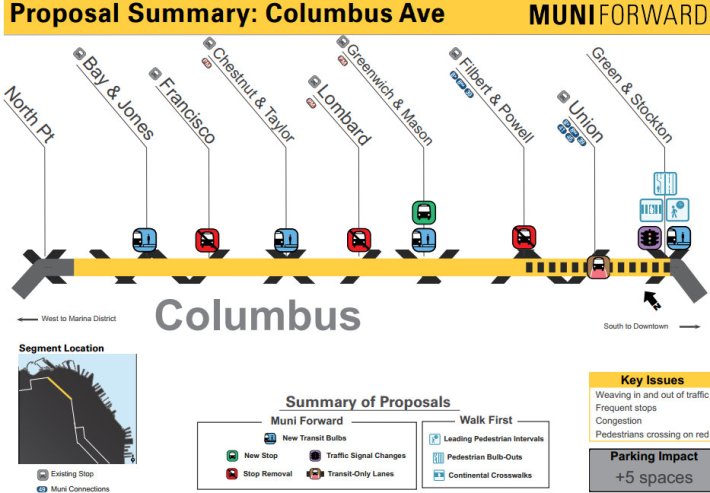
Muni's notoriously sluggish 30-Stockton line is finally set to get some upgrades that will give buses higher priority on streets through the dense neighborhoods of Union Square, Chinatown, North Beach, and near Fisherman's Wharf.
The plans, part of the SFMTA's "Muni Forward" program, include transit-only lanes, bus bulb-outs and boarding islands, transit signal priority, and stop consolidation on Stockton, Kearny, and North Point Streets, as well as Columbus Avenue. On two street segments where traffic lanes are too narrow to fit buses, car parking and traffic lanes would be removed to provide more maneuvering space.
The 30, one of Muni's slowest lines, averages a mere 3.6 mph between Market and Sutter Streets, according to a 2007 SF Chronicle article. Before leaving his position as a transportation reporter at the SF Examiner, Will Reisman raced the 30 at walking pace from Chinatown to Market -- and won.
The 30-Stockton takes 11 minutes to travel the mile-and-a-half segment north of Market, according to Muni Forward manager Sean Kennedy. The SFMTA estimates that upgrades could speed up the ride through that segment by about 27 percent, and result in a more reliable ride for roughly 70,000 daily riders that use the 30, 45-Union, and 8x-Bayshore Express through there.
A smoother, faster ride would especially benefit transit-dependent residents of Chinatown, which has the city's lowest rate of car ownership.
"It's such an oversubscribed route," said Cindy Wu, a community planner at the Chinatown Community Development Center. (Wu is rumored to be a top candidate for the mayoral appointment for the District 3 Supervisor seat vacated by David Chiu.) "Seniors and residents depend on it for everyday errands, whether it's grocery shopping or going to the doctor."
CCDC is "encouraged" by Muni's proposals to improve surface transit, said Wu, and those are still necessary "even though the Central subway is coming in" to connect Chinatown, Union Square, and SoMa. The 30 and 45 lines have been on a one-block detour near Union Square for four years to accommodate subway construction.

Wu noted that it's "still important to listen to community input" on the bus upgrades. A recent public outreach open house held in Chinatown by the SFMTA about the project was sparsely attended, but it's unclear why.
One attendee, Jim Fong, said he rides the 30 and 45 regularly, and that he's concerned about longer walking distances for seniors once stop spacing is increased from every block to every two blocks. Citywide, a 2010 Muni survey of riders found that 61 percent would consider walking a longer distance, if it meant the overall ride would be quicker and more reliable.
Aside from stop consolidation, the only point of contention for some seems to be proposals to remove car parking for transit upgrades. Chinatown residents and merchants don't seem to depend much on car storage, and they've been happy to ban car parking on Stockton Street to boost business during the busy Lunar New Year shopping season.
It's unclear how many car parking spaces would be removed in total for transit amenities, like 11 transit bulb-outs that allow for faster and easier boarding. Crosswalks at 18 intersections along the route would be made safer with bulb-outs, whether or not those intersections have bus stops.
The plans also include a two-block road diet on one-way Kearny Street, where the northbound 30 runs between Market and Sutter. Removing one of the street's four narrow traffic lanes would allow for wider traffic lanes that better fit buses, the SFMTA says. It's unclear if the road diet would extend beyond Sutter.

A similar treatment is planned for two blocks of Stockton, between Columbus and Broadway. There, 16 parking spaces would be removed to widen lanes from roughly 8.5 feet to 10.5 feet, giving buses more room to maneuver.
The lane widening there should provide relief at a bottleneck, where narrow lanes mean buses often must stop and wait for oncoming vehicles to pass. "We're losing up to a minute and a half there," said Kennedy.
Short segments of transit-only lanes are also planned on Columbus, from Powell to Stockton Streets, and on the north end of Van Ness Avenue, from Chestnut to Bay Street. The latter would extend the transit lanes already planned as part of Van Ness Bus Rapid Transit. The transit lanes on Columbus were already included in plans for a road diet on that street.
The SFMTA improvements are expected to be built next year, but bulb-outs at six intersections along the route [PDF] would be coordinated with a re-paving currently underway and will be installed within the next few months.





